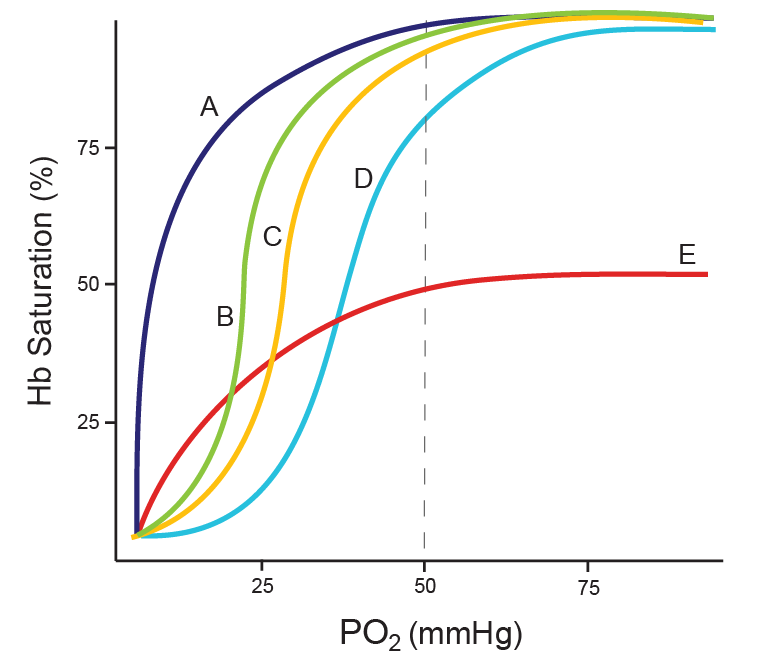WBR0868
Jump to navigation
Jump to search
| Author | [[PageAuthor::Serge Korjian M.D. (Reviewed by Serge Korjian)]] |
|---|---|
| Exam Type | ExamType::USMLE Step 1 |
| Main Category | MainCategory::Pathophysiology |
| Sub Category | SubCategory::Pulmonology |
| Prompt | [[Prompt::A 59-year-old woman presents to the emergency department for 2 days of severe vomiting after consuming some raw meat at a county fair. On admission, the patient is afebrile, her heart rate is 103/min, and her blood pressure is 92/64 mmHg. She appears frail and very uncomfortable. She is promptly rehydrated and blood is withdrawn for appropriate work-up. If the patient's oxygen dissociation curve is to be plotted on admission, which of the following curves would closely fit her current presentation? |
| Answer A | AnswerA::A |
| Answer A Explanation | AnswerAExp::This curve refers to the oxygen dissociation trend of myoglobin, typically exponential not sigmoid in shape due to the lack of allosteric interactions. |
| Answer B | AnswerB::B |
| Answer B Explanation | [[AnswerBExp::This curve typically depicts a left shift of the normal oxygen dissociation curve seen in situations of hypothermia, alkalosis, and low CO2 concentrations.]] |
| Answer C | AnswerC::C |
| Answer C Explanation | [[AnswerCExp::This curve represents the normal oxygen dissociation curve with typical P50 (50% of Hemoglobin saturated) at approximately 26 mmHg of PO2.]] |
| Answer D | AnswerD::D |
| Answer D Explanation | [[AnswerDExp::This curve typically depicts a right shift of the normal oxygen dissociation curve seen in situations of hyperthermia, acidosis, exercise and high CO2 concentrations.]] |
| Answer E | AnswerE::E |
| Answer E Explanation | AnswerEExp::This curve depicts both a left shift and a decrease in hemoglobin saturation usually seen in patients with CO poisoning. |
| Right Answer | RightAnswer::B |
| Explanation | [[Explanation::Metabolic alkalosis is a classical complication of excessive vomiting. As excess acid is lost, the arterial pH increases gradually. Acutely, before renal compensation begins excreting excess bicarbonate, the increasing pH causes a left shift in the oxygen dissociation curve, increasing oxygen affinity and binding at the level of the lungs but also causing less oxygen dissociation at the level of the peripheral tissues. Other factors causing a left shift include hypothermia, CO poisoning (although with a decrease in Hb saturation - Curve E), and low CO2 concentrations. A left shift in the oxygen dissociation curve signifies a lower P50, thus hemoglobin would reach 50% saturation at a lower partial pressure oxygen. Educational Objective: Metabolic alkalosis causes a left shift in the oxygen dissociation curve leading to increased affinity of Hb to oxygen. |
| Approved | Approved::Yes |
| Keyword | WBRKeyword::Metabolic alkalosis, WBRKeyword::Oxygen dissociation curve, WBRKeyword::P50, WBRKeyword::Carbon monoxide, WBRKeyword::Hypercapnia, WBRKeyword::Hyperthermia |
| Linked Question | Linked:: |
| Order in Linked Questions | LinkedOrder:: |
